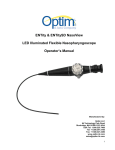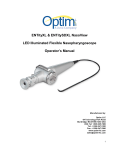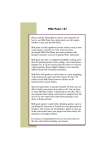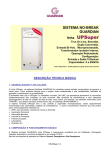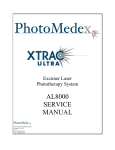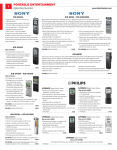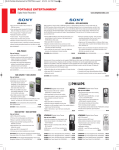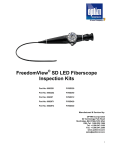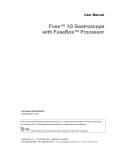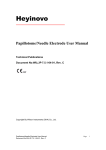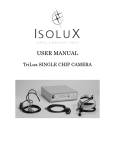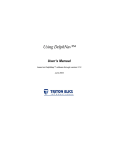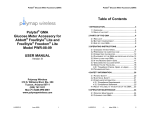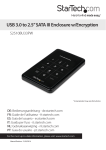Download Product user manual
Transcript
Portable LED Light Source (PLS) Operator’s Manual Manufactured by: Optim LLC 64 Technology Park Road Sturbridge, MA 01566-1253 USA USA Tel: 1.800.225.7486 Tel: +1.508.347.5100 Fax: +1.508.347.2380 www.optim-llc.com [email protected] 1 Table of Contents Page 1. Introduction ................................................................................................................................ 3 Indications ................................................................................................................................ 3 Precautions .............................................................................................................................. 3 2. Light Source Description, Specifications & Accessories ...................................................... 4 Light Source Control Body Diagram and Descriptions ............................................................ 4 Specifications ........................................................................................................................... 5 Accessories .............................................................................................................................. 5 3. Light Source Function and Operation ..................................................................................... 6 Light Source Preparation ......................................................................................................... 6 Light Source Operation ............................................................................................................ 6 Battery and Charger ................................................................................................................. 7 4. Care & Maintenance ................................................................................................................... 9 I - Methods of Light Source Reprocessing ............................................................................... 9 II – Light Source Reprocessing Protocol.................................................................................. 9 1. Pre-Cleaning .............................................................................................................. 9 2. Enzymatic Cleaning and Rinsing ............................................................................... 9 3. High-Level Disinfection ............................................................................................ 10 III – Drying the Light Source .................................................................................................. 10 5. Troubleshooting ....................................................................................................................... 11 6. Agency Compliance Statements and Guidance Tables ....................................................... 12 Guidance and Manufacturer’s Declaration – Emissions ........................................................ 12 Guidance and Manufacturer’s Declaration – Immunity .......................................................... 12 Guidance and Manufacturer’s Declaration – Emissions ........................................................ 13 Recommended Separation Distance between Portable and Mobile RF Communications Equipment ............................................................................................. 13 7. Repair Service .......................................................................................................................... 14 8. Warranty .................................................................................................................................... 15 9. Symbol Descriptions ............................................................................................................... 15 10. Regulatory .............................................................................................................................. 16 11. Vendor Information ................................................................................................................ 16 WARNING: This device is not supplied sterile. Clean and disinfect the device prior to use, employing the procedure listed in this manual. WARNING: This equipment is not suitable for use in the presence of flammable mixtures. WARNING: the following methods of sterilization and disinfection will result in damage to the light source and should not be used: Ethylene Oxide, autoclave, ultrasonic, chlorides, formaldehyde, and hydrogen peroxide. WARNING: In order to avoid potential safety hazards, the user of this device should consult the manuals of all Medical Electrical Equipment used in conjunction with this device. If this device is used with High Frequency Equipment, the attached endoscope should be medically approved for use with High Frequency Equipment, and the user should consult the manuals of all devices for safe operating voltage levels. This device is a TYPE BF Applied Part. It should only be connected to medically approved Type BF endoscopes that conform to IEC60601-1 and IEC60601-2-18. This equipment is rated IPX7. This device is covered under US Patents. For a complete listing visit our website at www.optim-llc.com/patents 2 1. Introduction Indications The Optim Portable Light Source (PLS) is intended to provide illumination for examination, diagnostic, and therapeutic applications, particularly in endoscopy. Please be sure to handle this optical instrument with care at all times. The electrical and optical components can be damaged by physical trauma, extreme temperatures, or fluid invasion into the light source. IMPORTANT: This instrument is intended for use by persons thoroughly trained in the techniques that employ this light source, such as endoscopy. WARNING: Avoid direct viewing of the high intensity light at the front of the Portable Light Source. Always connect and disconnect the light source with the light turned off. This manual describes the proper procedures for using the light source. The manual also contains pertinent information on the proper care and handling of the light source during use, reprocessing and storage. Please read this entire manual carefully before using the light source. If you have any questions concerning the material contained in this manual or the operation or safety of the equipment, please contact our customer service department. Precautions Damage may occur to the light source if used improperly. Read this Owner’s Manual thoroughly before attempting to use the light source. Check all items upon receipt to assure damage has not occurred during shipment. Verify compatibility of all components and accessories used with the light source by contacting Optim LLC at 1.800.225.7486 or 1.508.347.5100 Avoid storing or using the light source in areas of heavy traffic where the light source may sustain physical damage. Avoid immersing the light source for periods of time greater than recommended by the disinfectant manufacturer. Prolonged immersion may damage the exterior of the light source and could result in fluid invasion into the light source. Do not attempt to disassemble the light source in any way. There are no user-serviceable parts and disassembly will void all warranties. Avoid looking directly into the light source when it is on. Prior to use, check the outer surface of the light source, endoscope and any endoscopically-used accessories for rough surfaces, sharp edges, or protrusion that may cause a safety hazard. 3 2. Light Source Description, Specifications & Accessories Light Source Control Body Diagram and Descriptions Light Guide Post / Adapter Nut Light Intensity Switch Light Intensity Indicator Battery Cap Figure 1. Portable Light Source Diagram Adapter Nut: The adapter nut allows the portable light source to attach to the user’s endoscope. Rotate the nut clockwise to attach the light source to an endoscope and counterclockwise to remove the light source. The standard configuration of the Optim PLS is with an Adapter Nut that threads onto the standard universal light guide post’s Storz adapter thread. Light Intensity Switch: The light intensity switch controls the on/off and intensity functions of the portable light source. Moving the lever towards the wider end of the intensity indicator will turn the light source on and increases the light intensity; moving the lever towards the narrower end of the intensity indicator decreases the light intensity and turns the light source off. Battery Cap: The battery cap seals the battery and electronics within the control body. 4 Specifications Parameter Body Diameter Overall Length Weight (with battery) Battery Life at Full LED Power Battery Charge Time Battery Type Power Source Mode of Operation Safe Operating Ambient Temperature Range Safe Storage and Transport Temperature Range Safe Operating, Storage, and Transport Relative Humidity Range Battery Recharge Cycles RoHs Compliant Specification 27mm [1.06 in] 89mm [3.51in] 90g [3.2 oz] 45 minutes 2 hours Lithium Ion 3.6V, 700mAHr minimum Internally Powered Continuous 15 – 33ºC [59 - 91°F] -25 – 50ºC [-13 - 122°F] 0 – 95% RH 500 recharges Yes Accessories Light Sources & Accessories Listing Portable Light Source Kit Portable Light Source (Storz Adapter Thread) Rechargeable Battery Battery Charger Cradle Battery Charger AC/DC Adapter (US Plug) Battery Charger AC/DC Adapter (European Plug) Battery Charger AC/DC Adapter (UK Plug) Battery Cap O-Ring (pack of 1) Operator’s Manual Shipping Box Part Number PLS Kit F0063873L1 F006176PXF F006107PF F0069201F F0069202F F014386F F015061 N014784D R006414P 5 3. Light Source Function and Operation Light Source Preparation Before use, the light source should be reprocessed. Please refer to the Care & Maintenance Section of this manual for proper reprocessing protocol. Light Source Operation Figure 2. Attaching the Portable Light Source to a rigid scope Hold the light source so that the main body fits comfortably in one hand, allowing easy manipulation of the adapter nut with the thumb and forefinger. Tighten the adapter nut onto the endoscope light post by turning clockwise. Do not thread the light source by turning the light source body – only rotate the adapter nut. NOTE: The endoscope may have included adapters that are supplied attached to the light post prior to shipping, unthread adapters prior to attaching the PLS. Light Intensity Switch Intensity Indicator Figure 3. Intensity Control Switch Turn on the light source by rotating the light intensity switch towards the wider end of the intensity indicator. Adjust the brightness to the desired level by rotating the intensity switch further. 6 At the completion of use, turn the light source off by rotating the light intensity switch towards the narrower end of the intensity indicator. Remove the light source from the endoscope by rotating the adapter nut counterclockwise Avoid leaving the light source on for extended periods of time when not in use, as this will drain the battery unnecessarily. Battery and Charger Li-ion Battery Battery Cap O-Ring Figure 4. Removing the battery cap and inserting and removing the Li-Ion Battery The PLS’s internal LED light source operates on a single, Lithium-ion battery and provides approximately 45 minutes of continuous operation when a new battery is fully charged. To insert a new battery, align the battery with the cutout in the battery compartment, making sure the end of the battery with the two gold electrical contacts is inserted into the battery compartment first. Once a charged battery is inserted into the light source body, replace the batter cap by screwing the cap clockwise until a tight seal is made. To remove the battery, simply unscrew the battery cap and turn the light source upright until the battery falls out. Please take care not to let the battery fall to the floor or onto a hard object, which could damage the battery. CAUTION: Do not incinerate the battery Do not expose the battery to high temperatures above 122ºF/50ºC Do not disassemble the battery Do not short circuit the battery WARNING: The battery should be removed if the equipment is not likely to be used for some time. 7 DC in Jack AC Adapter Battery Contacts Status Indicator Charger Indicator Figure 5. Battery Charger and End Views of Battery To charge a battery: First plug the AC adapter into a wall outlet. Connect the AC power adapter to the DC IN jack located at the back of the charger. The “STATUS” indicator will be solid RED when the charger is ready and the “CHARGE” indicator will be flashing GREEN when the charger is waiting for a battery to charge. Slide the battery into the charger, making sure the end of the battery with the two gold electrical contacts is inserted into the charger first. The “CHARGE” indicator will turn RED when the battery is charging. The “CHARGE” indicator will alternately flash RED and GREEN when the battery has been charged to over 90%. When the battery is fully charged, the “CHARGE” indicator will turn solid green. After the battery has been fully charged, slide the battery out of the charger and unplug the AC adapter for the charger. CAUTION: Do not expose the charger to fire, water or moisture To avoid electrical shock, do not disassemble the charger No user-serviceable parts inside the charger Follow local regulations for disposal of electrical components or batteries. WARNING: The battery charger is not a medical device and should not be used in a room where a patient may be present. When the end-user wishes to discard this product, it must be sent to separate collection facilities for recovery and recycling. 8 4. Care and Maintenance I – Method of Light Source Reprocessing WARNING: Failure to comply with the following may result in damage to the light source and will void the product warranty. The PLS is rated IPX7 for protection against ingress of water. The entire light source is submersible in water and disinfectant solutions. However, the light source should not remain immersed in water or cleaning solutions for prolonged periods of time. After the disinfection cycle has concluded, remove the light source from the disinfection solution, dry the light source, and store the device in a clean and dry environment. Thorough cleaning and rinsing are the first and most important steps in the reprocessing of your light source. Without thorough cleaning and rinsing, it might not be possible to achieve high-level disinfection. Cleaning is the removal of all adherent visible soil (i.e. blood, protein substances and other debris) from the surface, crevices and joints of the light source. Use caution when cleaning and disinfecting your light source; some methods may be harmful to the light source and could result in extensive damage. Manual cleaning is the recommended method for cleaning your precision light source. To be effective, cleaning agents must assist in the removal of residual organic debris without damaging the device. No single cleaning agent removes all types of debris or is safe to use with every type of reusable device. Certain cleaning agents may damage the device’s materials. Cleaning agents should be used in the correct dilution/concentration and at the correct temperature in accordance with the cleaning agent manufacturer’s directions. Please contact Optim LLC’s Service Center at 1.800.225.7486 or 1.508.347.5100 to verify the compatibility of a cleaning method not listed below under Section II. Light Source Reprocessing Protocol. WARNING: Ensure that the battery cap is fully tightened on the o-ring seal to prevent liquid intrusion into the battery compartment. WARNING: Remove the battery prior to immersing into solutions. II- Light Source Reprocessing Protocol: 1. Pre-Cleaning 2. Enzymatic Cleaning and Rinsing; Enzol Fast Acting Enzymatic Cleaner or equivalent 3. High-Level Disinfection with CIDEX OPA (0.55% ortho-Phthalaldehyde Solution) Pre-Cleaning: Optim recommends the light source be pre-cleaned immediately after the device has become contaminated. This will prevent patient material from adhering to the light source. Dried material is difficult to remove and can render the disinfection or sterilization process ineffective. Gently wipe all debris from the exterior surfaces using a soft, lint-free cloth and water to which you have added a low sudsing detergent, diluted in accordance with the detergent manufacturer’s instructions. Enzymatic Cleaning and Rinsing 1. Fill a basin with a freshly made solution of water and a low sudsing detergent, diluted in accordance with the detergent manufacturer’s instructions. 2. Immerse the light source. Wash all debris from the exterior of the light source by gently brushing and wiping the instrument while submerged in the detergent solution. 9 3. Rinse the light source in clean water. 4. Wipe dry the exterior of the light source with a soft, clean cloth. High-Level Disinfection with CIDEX OPA (0.55% ortho-Phthalaldehyde Solution): 1. Prepare the disinfectant solution in accordance with the solution manufacturer’s label. 2. Completely immerse the light source in the disinfectant solution for the recommended time and temperature as indicated on the label of the disinfectant. 3. Thoroughly rinse the exterior of the light source with large amounts of clean water. NOTE: “It is suggested that all rinsing after disinfection should be done with water that has been filtered by passage through a 0.2 micron filter or otherwise treated by a method documented to improve the microbiological quality of water.” ASTM F 1518 4. A final rinse using 70% isopropyl alcohol solution can be used to speed the drying process and reduce the numbers of any organisms present as a result of rinsing with potable water. 5. Dry the exterior of the light source with a soft, clean towel. III- Drying the Light Source: If the PLS becomes wet, either from reprocessing or cleaning fluids, thoroughly dry the exterior immediately. Rinsing with isopropyl alcohol, followed by drying with a compressed gas, such as compressed air or commercial compressed gas canisters, is highly recommended to reduce contamination of the glass light guide and reduce the possibility of oxidation of the materials used in the construction of the light source. WARNING: Do not permit the light source to remain in cleaning or disinfectant solutions longer than the manufacturer’s recommended treatment time. Do not permit the light source to remain in any liquids for prolonged periods of time. In addition, if the PLS becomes wet, thoroughly dry the battery cap seal around the o-ring, with compressed gas or by thoroughly wiping any excess liquid from this area, prior to removing the battery cap. This will prevent any trapped fluid from inadvertently entering the battery compartment and exposing the electronics to fluids. WARNING: Ensure there is no trapped liquid between the battery cap and light source body prior to removing the battery cap. Note: Preventative Maintenance: Over time the O-ring on your PLS battery cap may become dry. To prevent the O-ring from cracking and falling off we recommend replacing the O-ring with the provided greased O-ring every 6 months or 300 disinfectant cycles. Battery Cap O-ring Figure 6. Replacing the O-ring 10 5. Troubleshooting PROBLEM POSSIBLE CAUSE Loss of Illumination ACTION Battery power is low. Replace battery with a freshly charged battery. Battery cannot supply sufficient current at this power setting. Change battery for a freshly charged battery. Reduce the light intensity and continue using the current battery. Recharge the battery as soon as possible. The endoscope has an adapter on it’s light post Refer to the guide below and remove the adapter The endoscope and light source do not have a compatible coupling system Contact Optim’s Customer Service Department 800.225.7486 Light intensity is low Foreign material or film on LED output taper Clean the taper with a cotton swab wet with isopropyl alcohol until the debris or film is cleared off. Dry with compressed air or gas. Light source becomes hot after prolonged use at full power. Light source has been left on for more than 30 minutes at full power. Turn the light source to a lower intensity setting if the examination must continue past 30 minutes. Or, turn the light source off for a few minutes to permit adequate cool down of the light source body. Light Guide does not attach properly to the endoscope Figure 7. Standard Universal Light Guide Post The standard light guide post consists of a snap-ring groove for an ACMI fitting connection, a Wolf adapter thread, and a Storz adapter thread. The PLS attaches to the Storz adapter thread/ Wolf / ACMI, providing a secure connection between the light source and light guide within the scope. If an adapter sleeve (see Figure 7 below) is on the light guide post, it must be removed prior to connecting the PLS to the Storz adapter thread. Figure 8. Standard Universal Light Guide Post (left), Post with Wolf Adapter (center), and Post with Storz Adapter (right) 11 6. Agency Compliance Statements and Guidance Tables Medical Electrical Equipment needs special precautions regarding EMC and needs to be installed and put into service according to the EMC information provided in this section. Portable and Mobile RF communications Equipment can affect Medical Electrical Equipment. WARNING: The equipment or system should not be used adjacent to or stacked with other equipment and that if adjacent or stacked use is necessary, the equipment or system should be observed to verify normal operation in the configuration in which it will be used. The PLS is intended for use in the electromagnetic environments specified below. The customer or user of the PLS should ensure that it is used in such an environment. Guidance and Manufacturer’s Declaration – Emissions Emission Test Electromagnetic Environment – Guidance Compliance RF Emissions CISPR 11 Group 1 RF Emissions CISPR 11 Class B Harmonics IEC 61000-3-2 N/A Flicker IEC 61000-3-3 N/A The PLS uses RF energy only for its internal function. Therefore, its RF emissions are very low and are not likely to cause any interference in nearby electronic equipment. The PLS is suitable for use in all establishments, including domestic, and those directly connected to the public low-voltage power supply network that supplies buildings used for domestic purposes. Guidance and Manufacturer’s Declaration – Immunity Immunity Test EN/IEC 60601 Test Level Compliance Level ESD EN/IEC 61000-4-2 ±6kV Contact ±8kV Air ±6kV Contact ±8kV Air EFT EN/IEC 61000-4-4 Surge EN/IEC 61000-4-5 Voltage Dips/Dropout EN/IEC 61000-4-11 ±2kV Mains ±1kV I/Os ±1kV Differential ±2kV Common >95% Dip for 0.5 cycle 60% Dip for 5 Cycles 30% Dip for 25 Cycles >95% Dip for 5 Seconds 3A/m N/A, PLS is powered by internal battery and has no I/Os. N/A, PLS is powered by internal battery and has no I/Os. N/A, PLS is powered by internal battery and has no I/Os. Power Frequency 50/60Hz Magnetic Field EN/IEC 61000-4-8 3A/m Electromagnetic Environment – Guidance Floors should be wood, concrete or ceramic tile. If floors are synthetic, the RH should be at least 30%. N/A N/A N/A Power frequency magnetic fields should be that of a typical commercial or hospital environment. 12 Guidance and Manufacturer’s Declaration – Emissions Immunity Test EN/IEC 60601 Test Level Compliance Level Conducted RF EN/IEC 61000-4-6 3Vrms 150kHz to 80MHz N/A, PLS powered by internal battery; no I/Os. Radiated RF EN/IEC 61000-4-3 3Vrms 80MHz to 2.5GHz (E1)3V/m Electromagnetic Environment – Guidance Portable and mobile communications equipment should be separated from the PLS by no less than the distances calculated or listed below: D=(3.5/E1)(√P) 80 to 800MHz D=(7/E1)(√P) 800MHz to 2.5GHz Where P is the max power in watts and D is the recommended separation distance in meters. Field strengths from fixed transmitters, as determined by an electromagnetic site survey, should be less than the compliance levels (E1). Interference may occur in the vicinity of equipment containing a transmitter. Recommended Separation Distances between portable and mobile RF Communications Equipment and the PLS: Equipment and Systems that are NOT Life-supporting The PLS is intended for use in the electromagnetic environment in which radiated disturbances are controlled. The customer or user of the PLS can help prevent electromagnetic interference by maintaining a minimum distance between portable and mobile RF Communications Equipment and the PLS as recommended below, according to the maximum output power of the communications equipment. Max Output Power (Watts) Separation (m) 150kHz to 80MHz D=(3.5/V1)(√P) Separation (m) 80 to 800MHz D=(3.5/V1)(√P) Separation (m) 800MHz to 2.5GHz D=(3.5/V1)(√P) 0.01 0.1 1 10 100 N/A, Note 1 N/A, Note 1 N/A, Note 1 N/A, Note 1 N/A, Note 1 0.1166 0.3689 1.1666 3.6893 11.666 0.2333 0.7378 2.3333 7.3786 23.3333 Note 1: The PLS is internally battery powered and has no I/Os. Conducted RF Immunity testing does not apply, resulting in no separation data from 150kHz to 80MHz. 13 7. Repair Service Customer Service The PLS is serviced at Optim LLC’s manufacturing facilities in Sturbridge, MA, USA. Use the following procedure to expedite returned goods for evaluation, repair or replacement. 1. Telephone Optim LLC at 1.800.225.7486 or 1.508.347.5100 or complete the online RMA Request Form on our website (www.optim-llc.com/rma-request) 2. Provide a detailed description of the problem and include the serial number. 3. If the light source needs to be sent to Optim, a Returned Material Authorization number will be issued. 4. The light source should then be returned to the address below for repair or replacement. 5. Include a copy of the RMA inside the package. 6. Have RMA number visible on the outside of the package. Returning Goods to Optim LLC Ship the PLS in the carrying case and within a corrugated box to prevent damage during shipment. Ship to: Optim LLC 64 Technology Park Road Sturbridge, MA 01566-1253 USA Attention: Customer Service / RMA#______________ ATTENTION: If the light source has been used in a clinical setting, the light source must be reprocessed according to procedures outlined in the Care & Maintenance section of this manual before shipment to Optim LLC. Upon evaluation, the customer will be contacted and advised of the findings and estimated repair cost. Repairs will not begin until authorization or a purchase order is issued indicating the approval of charges. 14 8. Warranty The Optim LLC Portable Light Source (PLS) is warranted to be free from defects in materials and workmanship for a period of one (1) year from the date of purchase. All non-warranty repairs will be warranted to be free from defects in materials and workmanship for a period of ninety (90) days from the date of the invoice. Accidental damage and damage resulting from misuse, abuse, excessive sterilization, disinfection and sterilization methods not approved by Optim LLC, as well as fluid invasion and normal wear and tear, will be subject to prevailing repair charges. Disassembly, alteration, or repair performed by any person not authorized by Optim LLC will result in immediate loss of warranty. THE ABOVE WARRANTIES ARE IN LIEU OF ALL OTHER WARRANTIES EITHER EXPRESS OR IMPLIED, INCLUDING ANY WARRANTY OF MERCHANTABILITY OR FITNESS FOR A PARTICULAR PURPOSE. Suitability for use of the medical device for any surgical procedure shall be determined by the user. Optim LLC shall not be liable for incidental or consequential damages of any kind. All shipping charges to and from Optim's facility is the responsibility of the customer. 9. Symbol Descriptions Attention: Read Operating Manual for Warnings, Cautions, and Instructions for Use. This equipment is rated IPX7 and is protected against the effect of immersion between 15cm and 1m. S/N This symbol indicates the product’s Serial Number. This symbol indicates that this product is a Type BF applied part. Light intensity indicator. Light intensity switch. In the European Union, this symbol indicates that when the end-user wishes to discard this product, it must be sent to separate collection facilities for recovery and recycling. By separating this product from other household-type waste, the volume of waste sent to incinerators or landfills will be reduced and natural resources will thus be conserved. 15 10. Regulatory The PLS has been tested to, and found in conformance with, the following standards: IEC 60601-1 IEC 60601-1-1 IEC 60601-2-18 CSA C22.2#601.1.1 The CE mark on this product indicates that it conforms with the requirements of the European Medical Device Directive 93/42/EEC + 2007/47/EC (21.09.2007). Authorized Representative: Scanlan Group B.V. Postbus 75664 1118 ZS Schiphol Triport The Netherlands Telephone +31(0)20 653 0553 ISO 9001:2008 ISO 13485:2003 ISO14971:2007 FDA CGMP 820 CDN MDR CMDCAS MDD 93/42/EEC Annex VII 11. Vendor Information Manufactured and Serviced by: Optim LLC 64 Technology Park Road Sturbridge, MA 01566-1253 USA Website: www.optim-llc.com Sales & Service Email: [email protected] USA TEL: 1.800.225.7486 TEL: +1.508.347.5100 FAX: +1.508.347.2380 Part No. N014784D DCN No. 10514 January, 2015 16
















